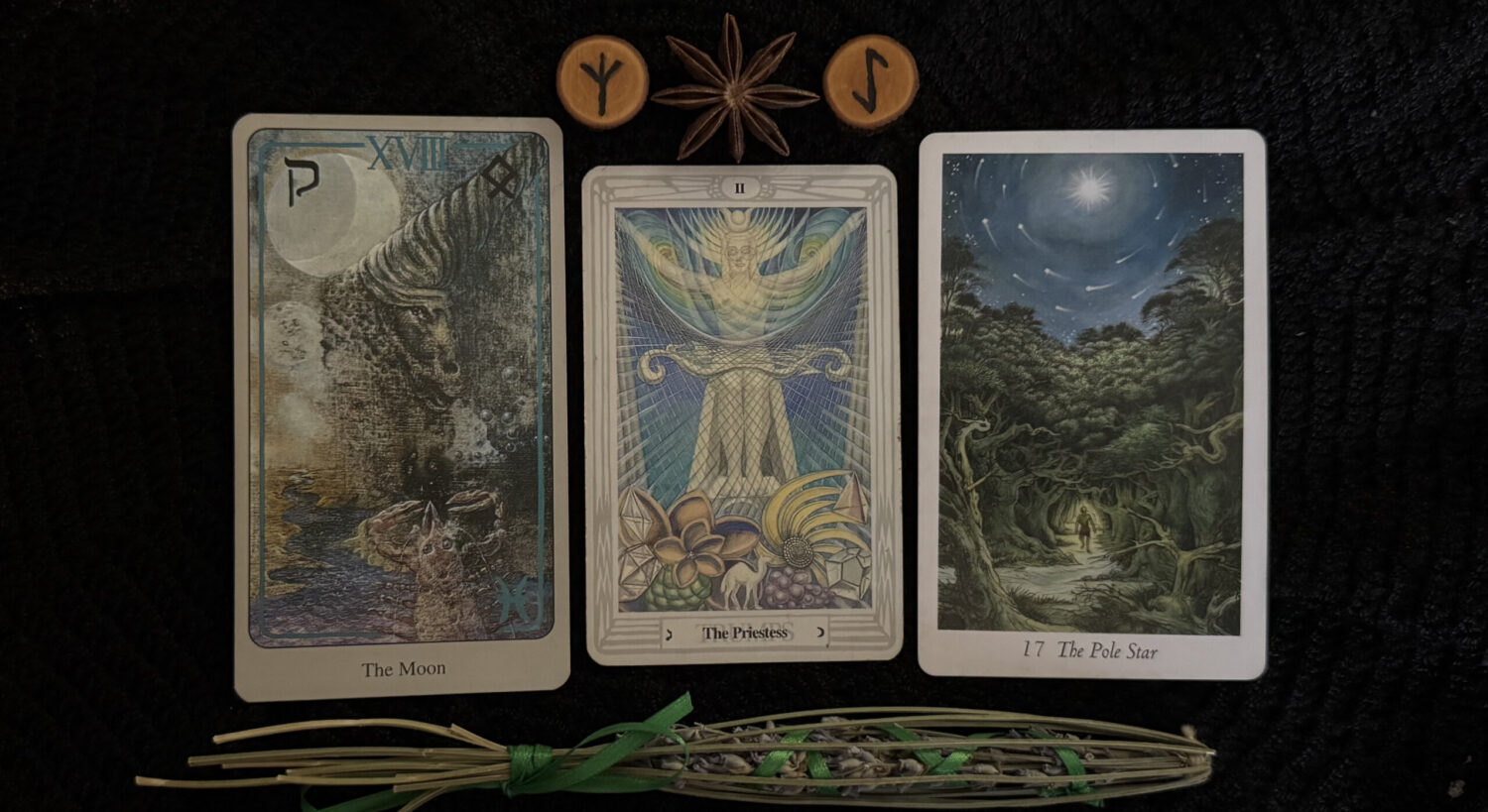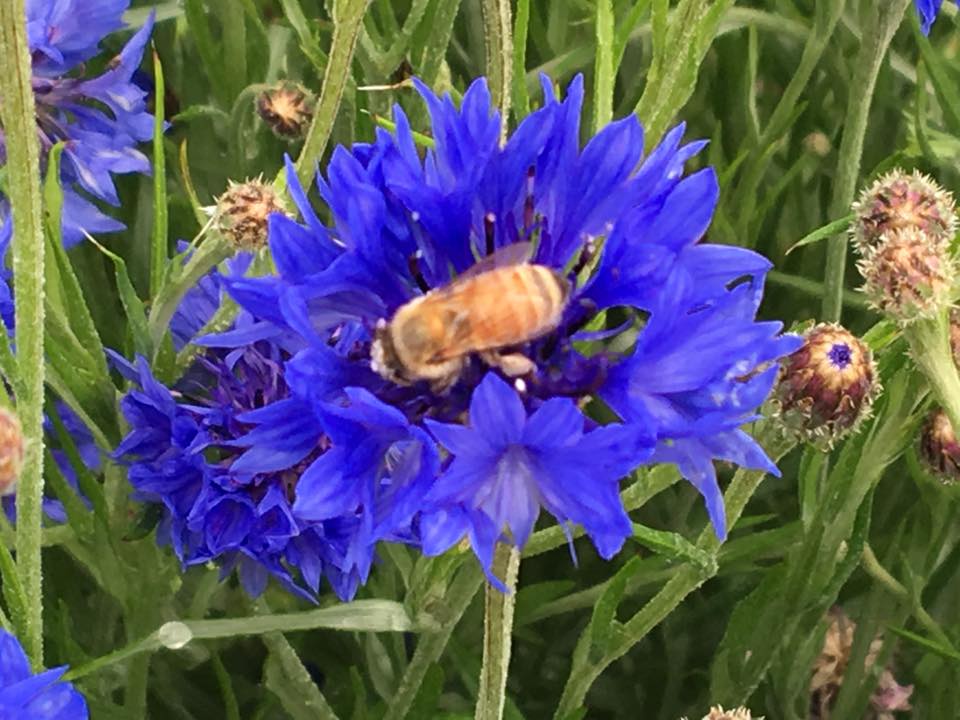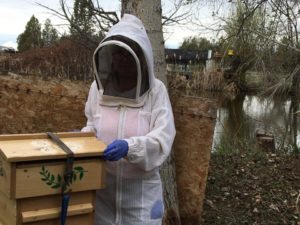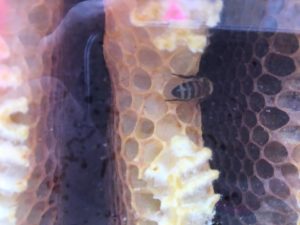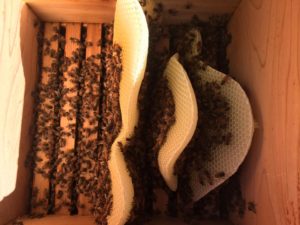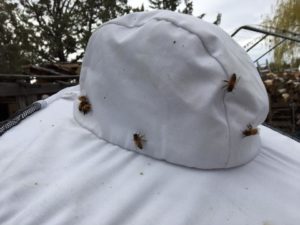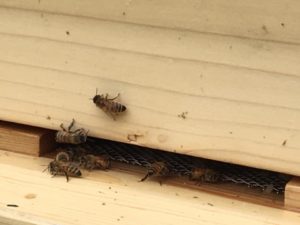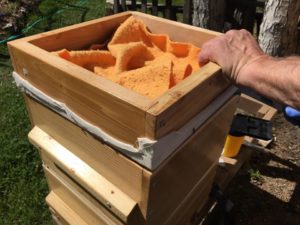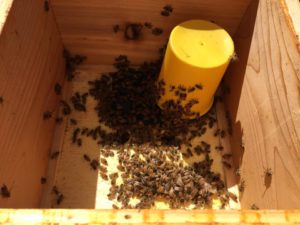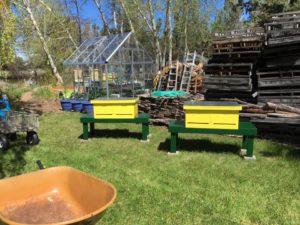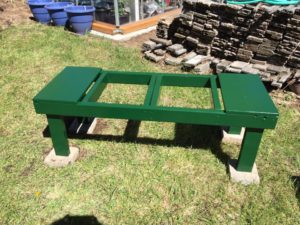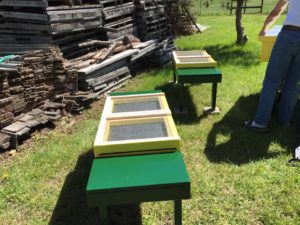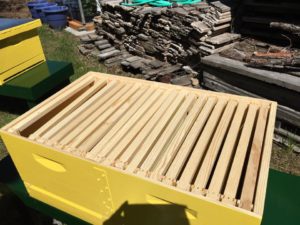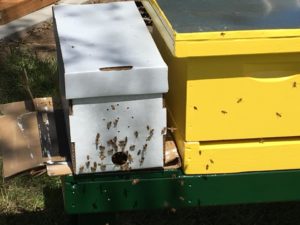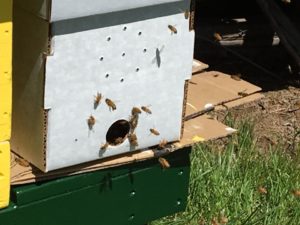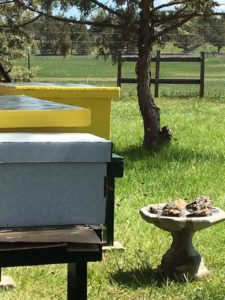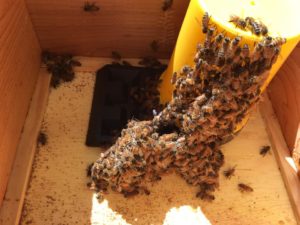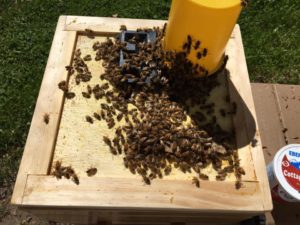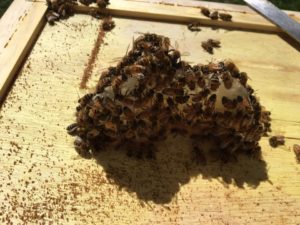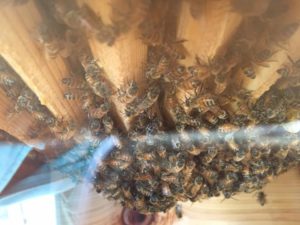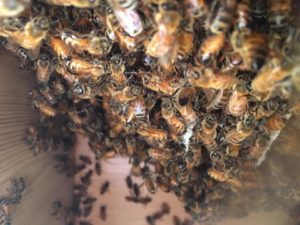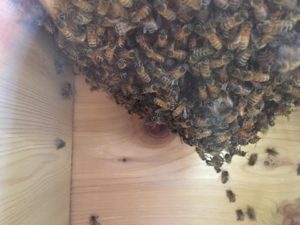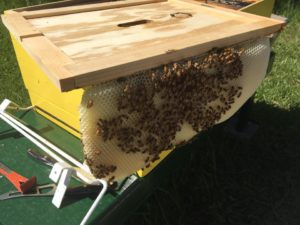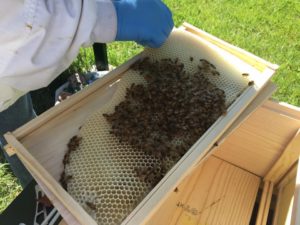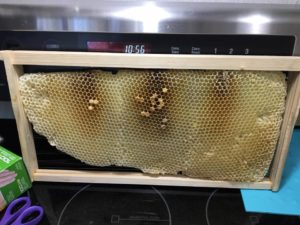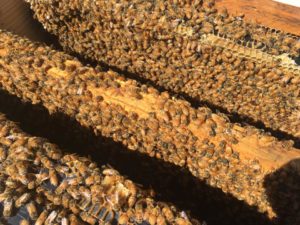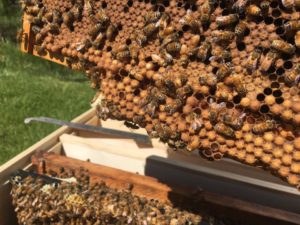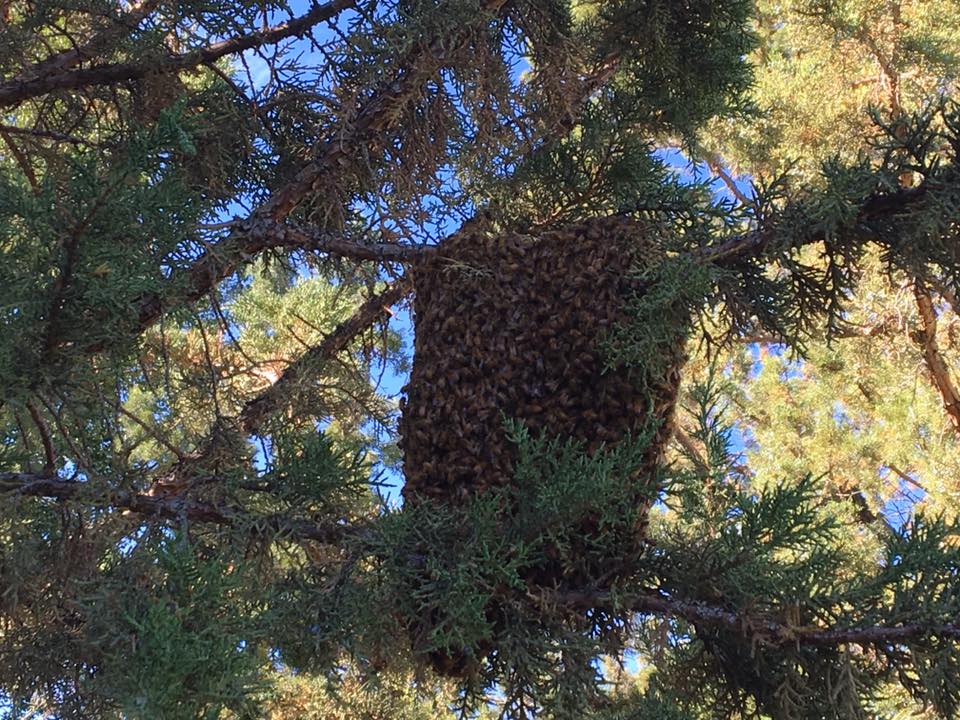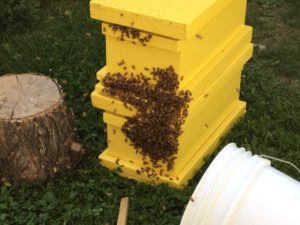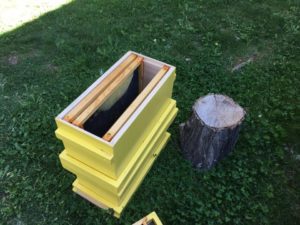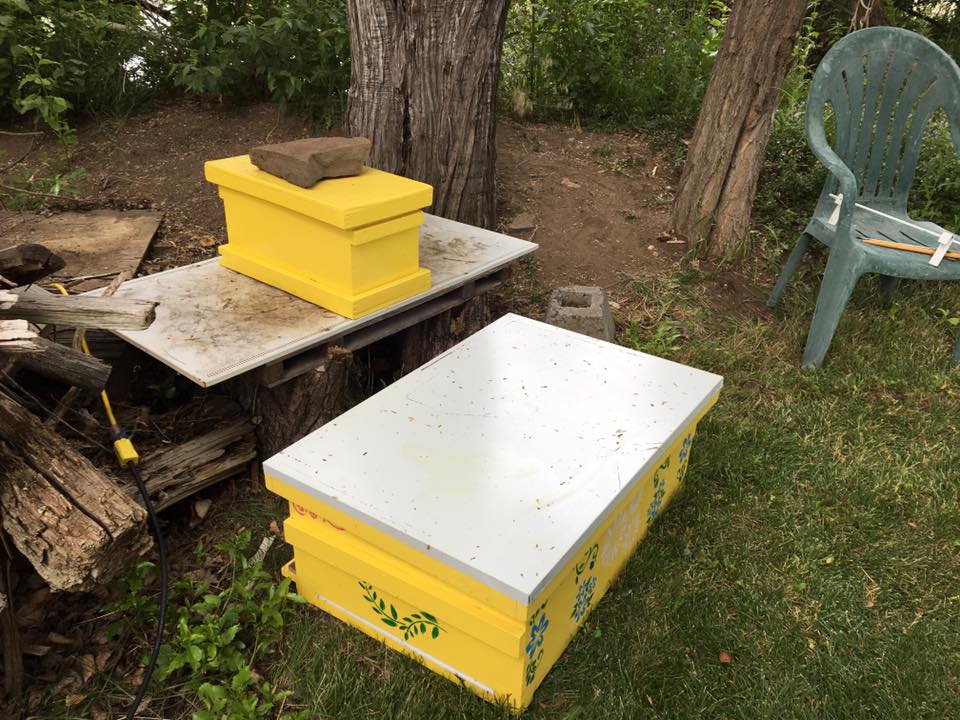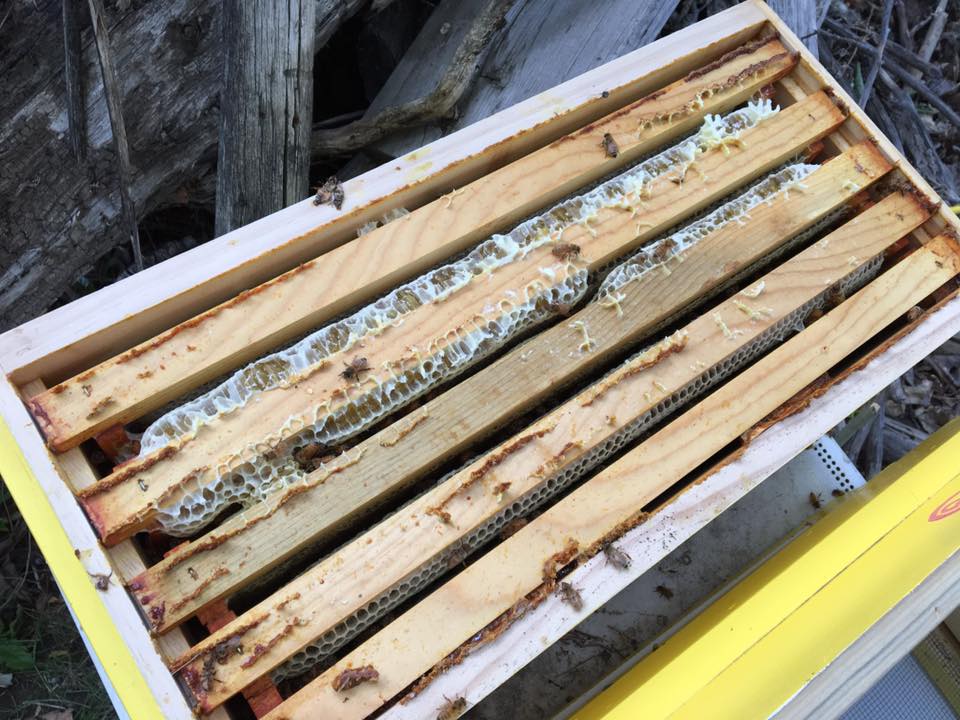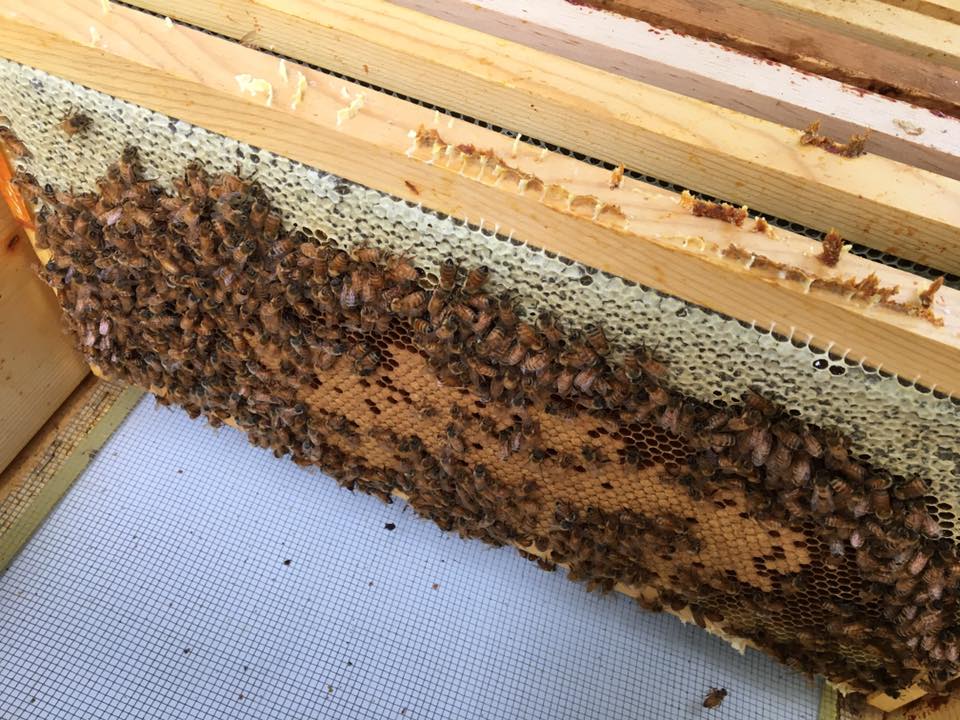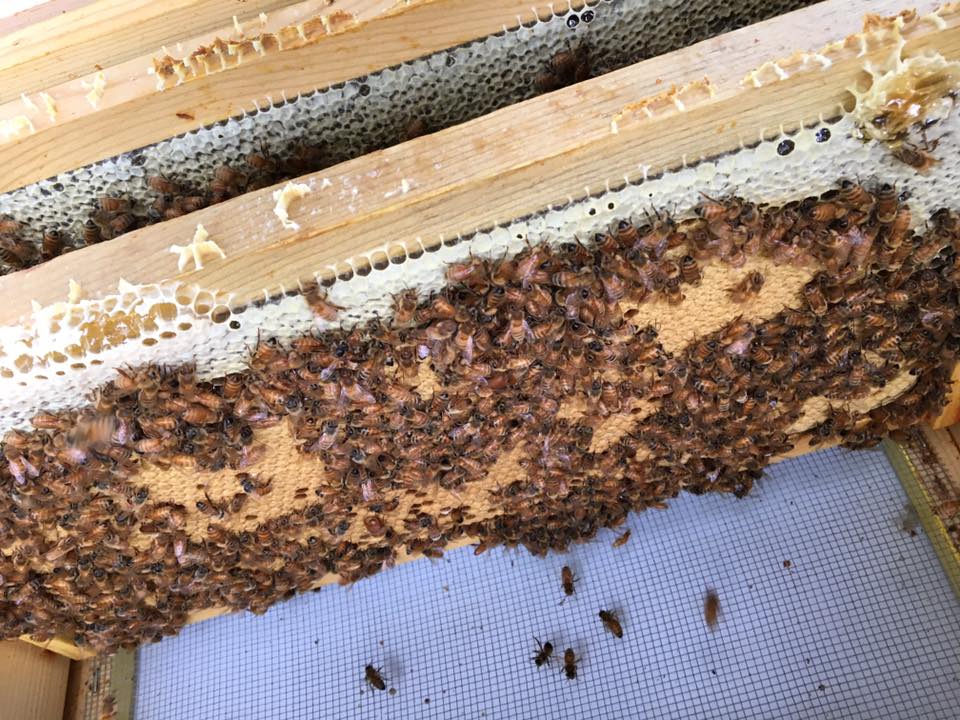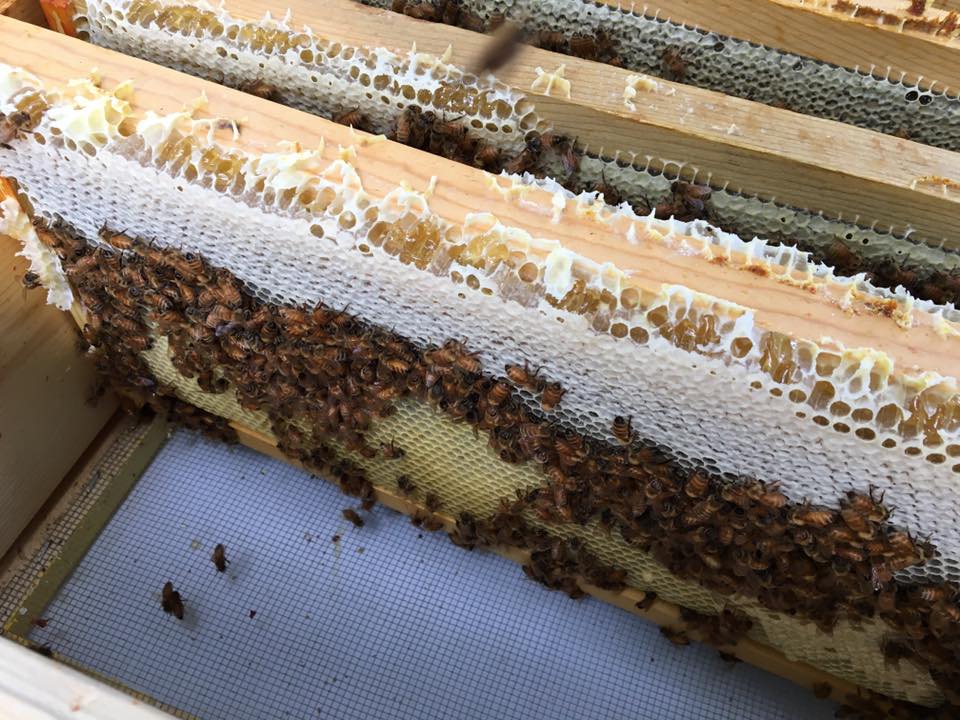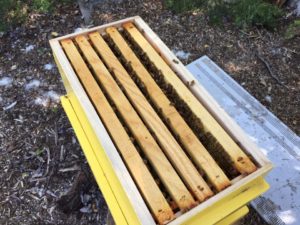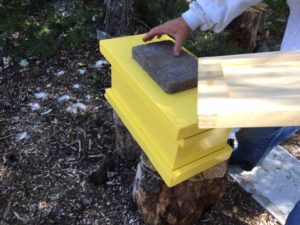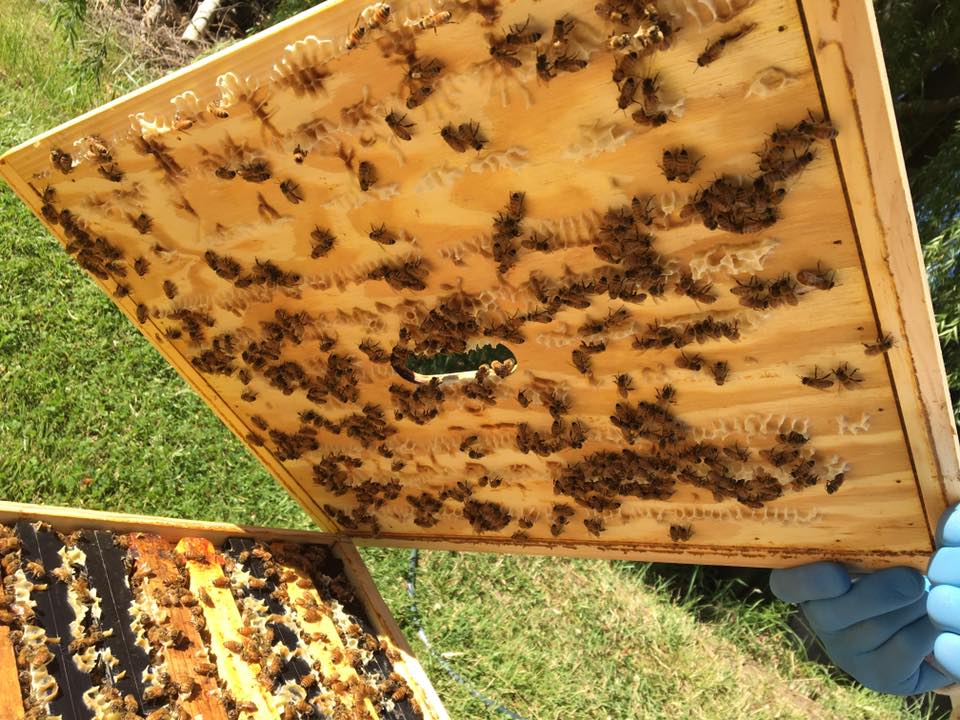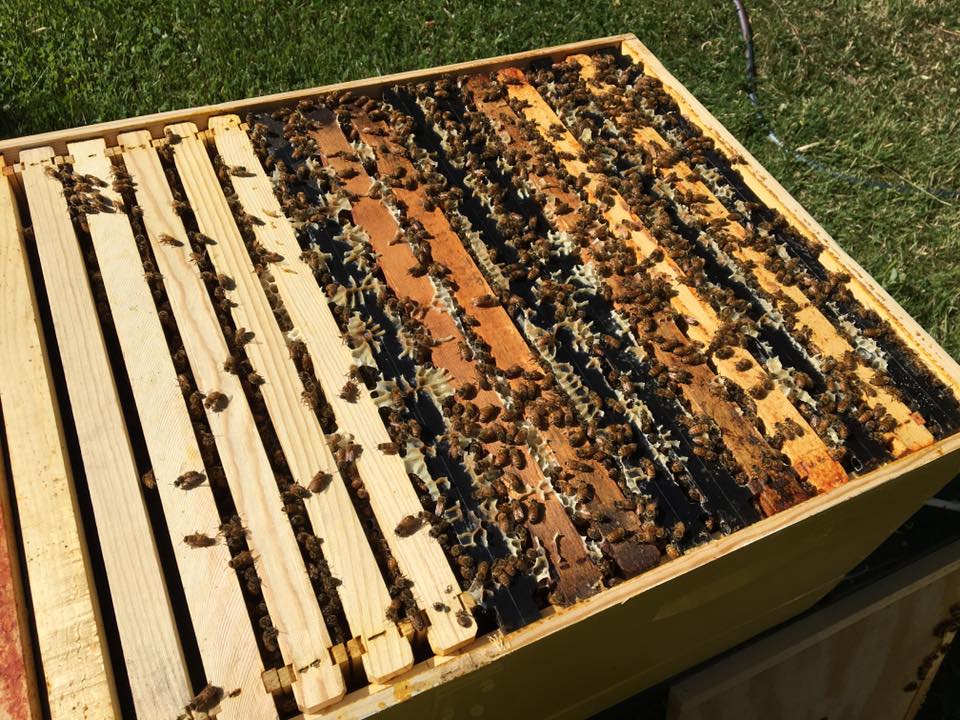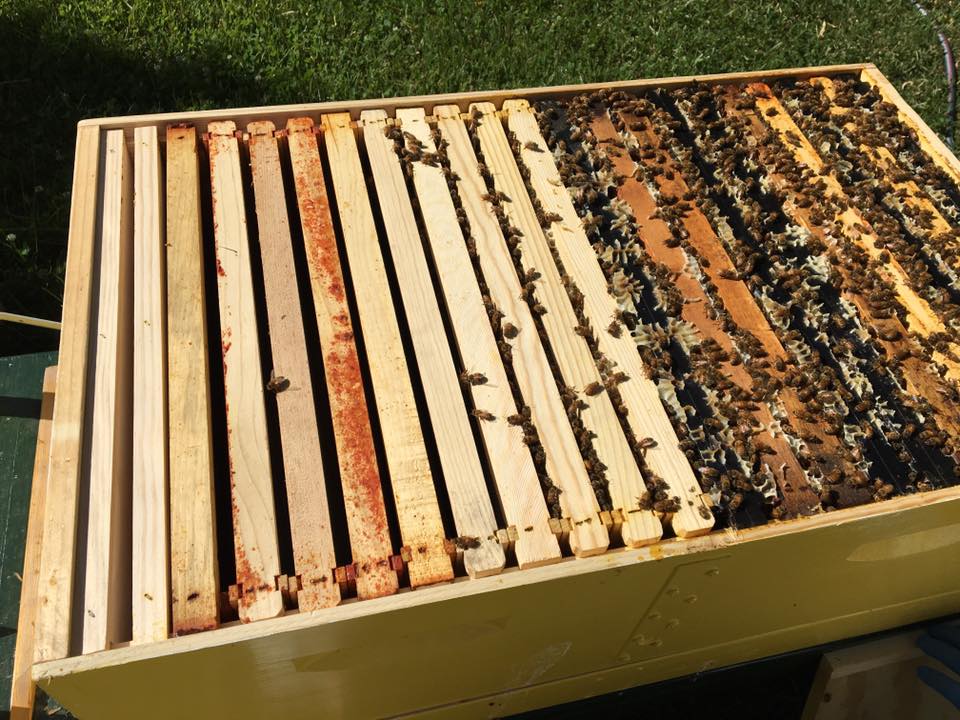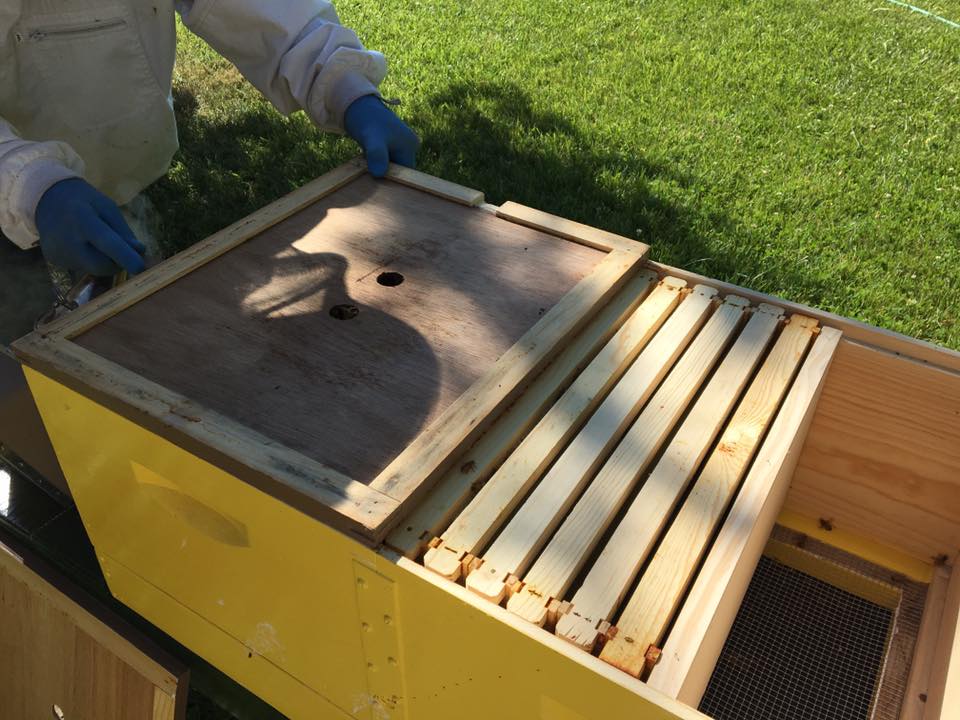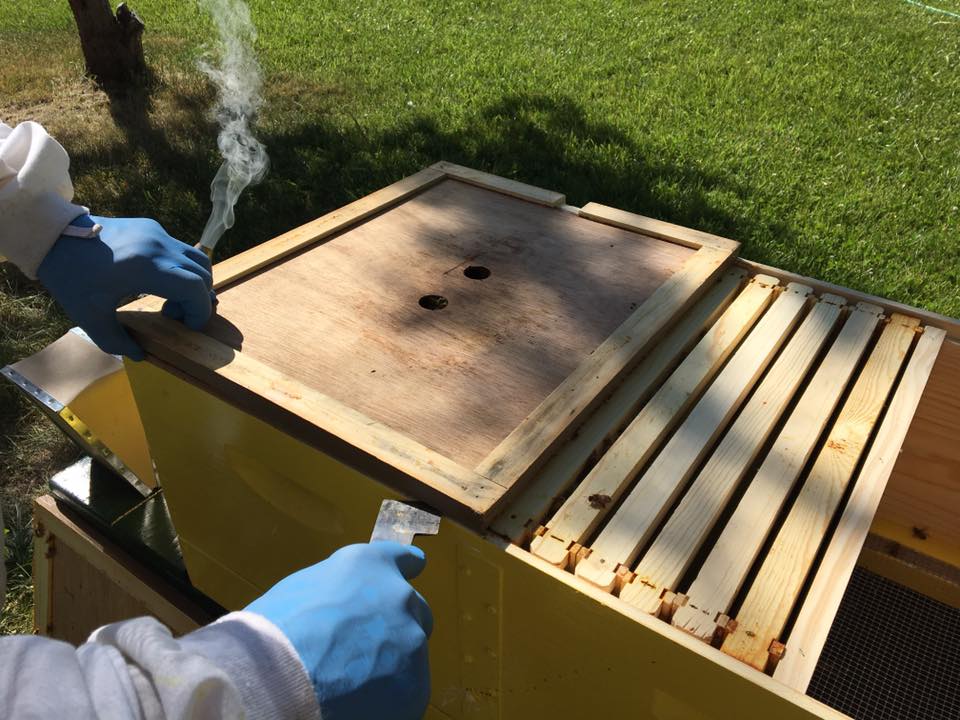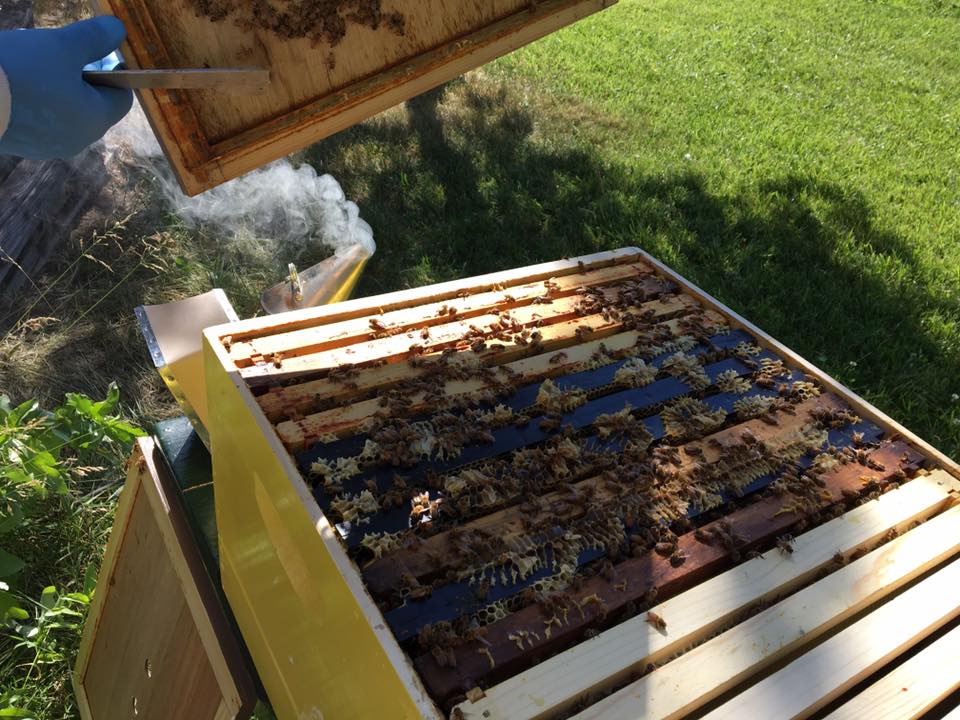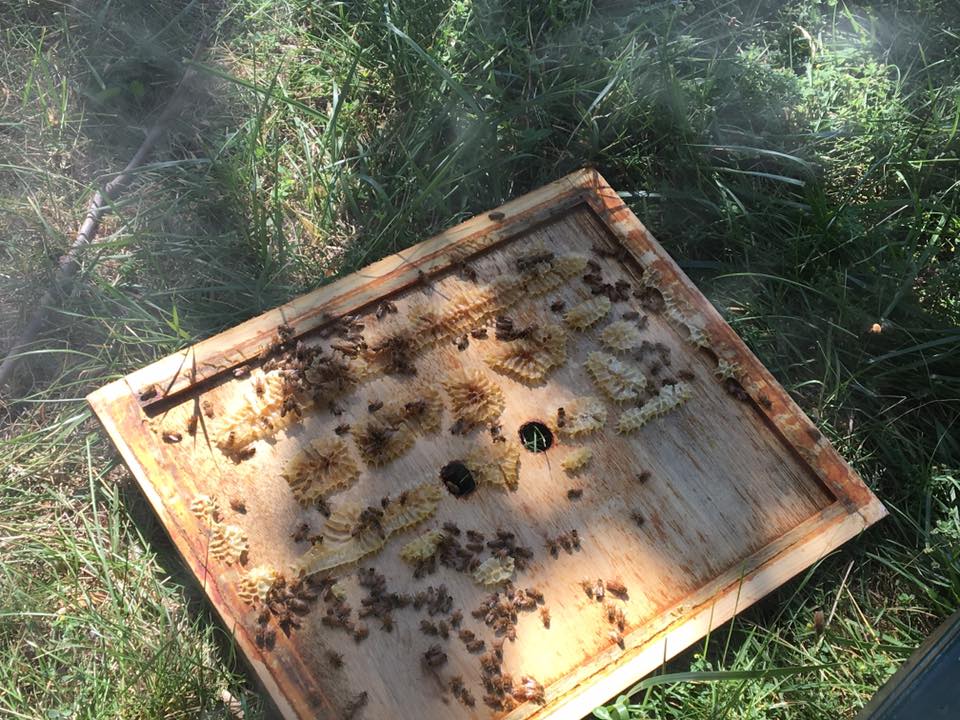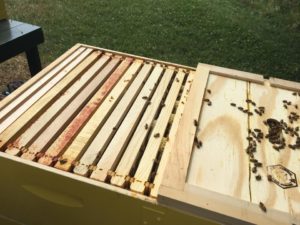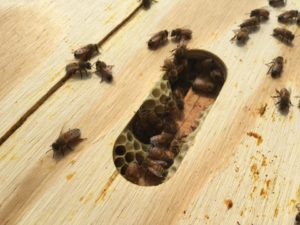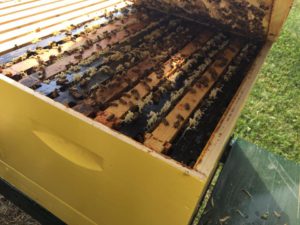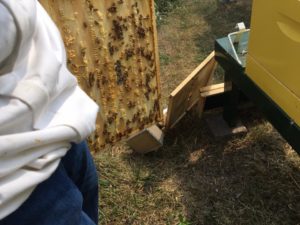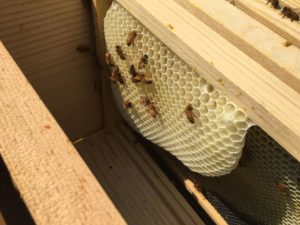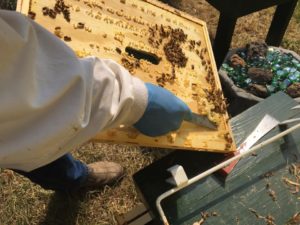To recap 2016, I split our original hive and it went well until the end of the season when they vanished. In all probability, they went back to their original hive right next door. But one day they were there, and the next they weren’t. No dead bees, nothing. Eventually, comb was all that was left. I’ll save that for next year. The same thing happened to the Warre’ hive. There, and then gone.
The original hive swarmed after the split which was very cool. We got them and they went back into their original hive. No clue if we ended up with two queens or if one killed the other, but it was amazing to experience. We bought a couple of Swarm Bandits from Brushy Mountain and we’ll use those next year to capture the swarm before it leaves. Plus we bought a bucket thing from Brushy Mountain as well that captures swarms up in trees. It would have been so much easier had we had that to capture our swarm with, saving time and our sanity.
The new long hive flourished. It seems to have created what it needs to survive the winter. I added two candy boards with pollen to the top of that hive as well as on the original hive. That did well last winter, so we bought some more for the new hives. Unfortunately, instead of fours hives going into winter, we only have two. With any luck, they’ll survive and we’ll be able to split them in the Spring and begin again with four.
We’re going to try to find the yellow jacket nest to try to deal with that nightmare. Or we’ll be hanging traps everywhere. We also plan to add more flowers..everywhere..continuing the planting we began last Spring. The idea is to create such a prolific area that the bees don’t need to fly far to get what they need. We already have much of that now, but it never hurts to over plant.
So, check back after the new year. We plan to fully commit to bee-centered beekeeping using natural methods in lieu of chemicals. We’ve never felt comfortable with it and now it’s time to take our cues from the bees. We don’t go into the hives all that often, every few weeks unless it’s for something specific. But each time, I keep a journal of what we do and I’ll put all of that here so that anyone interested can see what’s going on. And I’ll take lots of pictures.
So the bees and I will see you in the new year!
25 April 2017 – Warre Installation
We got the call yesterday that our package was in and we drove right down to pick it up. It was too cold to install the package when we got home, so we put the package in a protected area for the night and installed them the following day. It was different this year because we already had existing comb, and they got right to work when I dumped them in.
I like the bee suit I wear. It was expensive, but its layers let air through and I stay cool. Trust me, you don’t want to experience hot flashes in a bee suit. We keep the hive tied down to the hive stand because hives can tip over and here I’m getting ready to remove the tie downs and take the top off of the hive.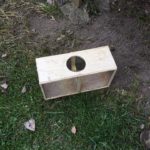
The picture at the right is of the box the package of bees arrived in. The queen is tucked away in her own cage with a cork in one end which I removed and replaced with a small marshmallow. The idea is that the queen will eat her way out as the worker bees eat their way to her. It’s a way for them to get to know each other making her acceptance by the colony easier. The hole in the center is for the syrup can, the colony’s food source during transport. We’ll continue feeding syrup for a few weeks until they become more established. It helps with comb building.
It was nice to have some comb and I have a picture here of some runaway comb that was built last year. I took that and I’m using it for salves, but I wanted to show what they can do when they’re left to their own devices as well as what they look like on last year’s comb.
Anyway, we took apart the hive and cleaned up a bit from last year and poured in the bees after placing the queen cage at the bottom of the brood box. They investigated both of us, crawling all over us while we worked with the hive. It’s an amazing experience to interact with bees. It’s not what people think and aligning with their frequency is so calming.
After putting the hive back together, we stood back and watched as they flew in and out discovering their new surroundings. Losing all of our hives left us so bereft and hearing them once more was the best thing ever.
4 May 2017 Hive Check – Warre
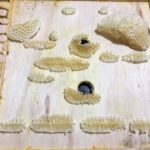 It’s so exciting to check a hive for the first time to see what they’ve been up to. You never know. Sometimes they do what’s expected, and sometimes they have a mind of their own. Jerry had created an inner cover for the Warre so that we could put a feeder inside the hive. Leaving it outside encourages robbers and we don’t want that, so he went to work creating an inner cover. He did a really nice job on it and it worked well. Of course, the bees had other ideas.
It’s so exciting to check a hive for the first time to see what they’ve been up to. You never know. Sometimes they do what’s expected, and sometimes they have a mind of their own. Jerry had created an inner cover for the Warre so that we could put a feeder inside the hive. Leaving it outside encourages robbers and we don’t want that, so he went to work creating an inner cover. He did a really nice job on it and it worked well. Of course, the bees had other ideas.
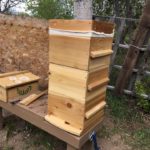 I wanted to show a picture of what the hive looks like with all the boxes on it. The top box which has the cloth bottom and the cloth insert allows for air to come in and moisture to wick out. On Langstroth hives, new brood or honey boxes are added to the top, but on a Warre, they’re added to the bottom. Some beekeepers use the Rose hive method and add them in the middle. Again, we’re trying to outsmart beings far more intelligent than we are. Silly.
I wanted to show a picture of what the hive looks like with all the boxes on it. The top box which has the cloth bottom and the cloth insert allows for air to come in and moisture to wick out. On Langstroth hives, new brood or honey boxes are added to the top, but on a Warre, they’re added to the bottom. Some beekeepers use the Rose hive method and add them in the middle. Again, we’re trying to outsmart beings far more intelligent than we are. Silly.
The bees were doing well, so we closed up the hive after giving them some more food. I had given them a piece of a pollen cake along with their syrup and they had found it and were overjoyed.
4 May 2017 Horizontal Hive Install
We picked up the nucs and brought them home to install into the horizontal hives Jerry put together. We purchased one from a supplier the year before and we really liked it so we thought we’d try making one from two Langstroth boxes. I think they turned out well. We expanded the apiary a bit and if the swarm boxes are successful, we’ll put those bees into the other hives which you can see through the greenhouse.
Jerry makes custom hive stands for each of our hives. He likes to have side tables for tools and such so the horizontal hives have that while the traditional and Warre hives have a table in the middle for supplies.
He built follower boards for inside the hives and screened bottom boards for the box to sit on. He did a really great job on both.
We put the nucs next to their respective hives to let them acclimate, pulling the plug out of each one so that the bees can fly about. The difference between a nuc and a package is that the nuc is essentially an intact five-frame hive with a queen and brood. A package contains 10,000 bees with a queen they haven’t accepted yet so it takes some time to establish and for the queen to take her mating flight as opposed to an already established nuc. In our case, we had existing comb so that sped things up for the Warre hive.
After letting them acclimate, we carefully took each frame out of their respective nuc boxes and placed them in the hive in the order in which we removed them from the nuc box. We like using foundationless frames to let the bees build their own comb, but most beekeepers alternate between foundationless and foundation to keep the foundationless frames straighter so we do that as well.
18 May 2017 Hive Check – Warre
Remember when I said above that bees have their own ideas about things? Well, they do. I went in to give them some more syrup and discovered that they had begun building comb on the feeder and the inner cover. See the May 4th picture of the cover above on the right for all the comb they began attaching on the underside to the top bars. They’re crafty. But the best was on the feeder itself.
Like I said, they’re crafty. When bees put comb or propolis where we don’t want it, we have to interfere and remove it. I don’t like to do that, but it is what it is. Sometimes we can’t get the frames back in properly without doing it but with top bar hive frames, it’s tricky. They can break off really easily so I try not to disturb much when I do it.
The picture to the right is of comb they built over the hole in the inner cover. They build where they please. But it was at this point that we decided to add another brood box. They were immediately interested.
24 May Hive Check – Warre
I took these through the observation window and it looks like their comb building is going well.
24 May 2017 Hive Check – Horizontal Hive
So as you can see, the bees in his hive have decided to build a beautiful piece of comb onto the inner top cover. Lovely. I cut it off and tried to insert it into a foundationless frame out in the apiary to no avail, so I took it in the house to do it there. The frames have small holes on the sides for fishing line or wire to help the stability of the comb. You can see that there’s some brood on it and I didn’t want to lose it so I’m glad I took the time to attach it to a frame.
And then we pulled some frames to look at what they’d done and found that they’d drawn the comb further down below a couple of frames. It was so beautiful that I left it. I don’t actually have the same concerns as other less bee-centered beekeepers. They filled up a space created by the structure of the new horizontal hives. These are essentially prototypes and Jerry’s watching to see what changes he needs to make for the future. I really don’t like lifting a heavy brood box and horizontal hives are the answer to that. So they can do whatever they want. If I can get a jar of honey from time to time or some comb or propolis to tincture, I’m happy.
You can see on the left how full the frames are and on the right where they’ve built comb below the frame. There’s no way that I’m going to touch that brood. It stays where they want it.
10 June 2017 Hive Check – Horizontal
Everything looked good and we added some more frames for them to build comb on, continuing to alternate foundationless with foundation frames.
19 June 2017
I added another brood box to the Warre hive after the middle box filled up. And the horizontal hives are doing well. Below is a video of the comb they built. The original box had comb in it from the colony that died and it’s really rockin’ right now. I think I added the middle brood box within three weeks of installing the package and they’re almost at the point where they’re attaching it to the observation window. Anyway, so far so good and the two horizontal hives Jerry built are also doing well. Now we’re waiting to see if any of our swarm traps will become homes to new bees. And maybe we’ll get brave and film our hive checks.
21 June 2017 ~ SWARM!!
Here’s a link to the swarm post I did rather than copying it over here, just click here. Thanks!
3 July 2017 ~ ANOTHER SWARM!!!
Well, it happened again. We were walking over to check out the growth on the corn and saw a beautiful swarm in the same tree. Not sure where it came from so it could have conceivably been from the same hive or maybe it was one that came through and landed on the same tree, but we think it was from the same hive. We were due to go into the original hive tomorrow and then this happened. So now we may take a peek, but maybe not. But it was amazing to stand out there among the swarm. There really isn’t anything like it. Here’s one of the videos. The others are on my YouTube page. This is so cool!!!
Here are some shots of the nuc box we put the bees in. It has comb already in it for them to start doing their thing.
4 July 2017 – installing the first swarm into the horizontal hive
Today we put the first swarm into their horizontal hive. I like the location of it. It’s by the pond and it’s secluded and quiet for them. This has been quite the experience.
I took some pictures of the frames as they came out. There was a really nice brood pattern and it’s clear the queen has been busy.
Hive and Swarm Check ~ 6 July 2017
We finally went into both horizontal hives and added an inner cover to the swarm box. We forgot to do that the last time and the bees were starting to attach to the lid which isn’t cool, so we donned our bee suits and quickly took the lid off giving ourselves a moment to look inside. They’re definitely on the frames, so that’s awesome!
We started with Hive A which didn’t swarm. It has always seemed really calm while the other one had an intensity about it. They’ve been doing their thing and expanding the colony. We added a few more frames, alternating between foundationless and foundation frames. We prefer the foundationless frames as do the bees, but alternating them seems to keep the comb straighter so we do that.
Hive B was calmer this time because the errant queen had already swarmed. Why another one did as well is a mystery, but I’m so glad she did. Five hives in the apiary are awesome! There was a bunch of burr comb to deal with on both hives but other than that, we didn’t pull any frames, particularly on this hive. We didn’t want to disturb any queen activity in there so we added some frames and closed it back up.
I got a bunch of burr comb I can clean up and use in salves and the bees are doing well!
7/16/2017 Swarm transfer and swarm hive 1 check
We transfered the second swarm into it’s new Langstroth hive box. We didn’t really see any brood however, so it may be that the swarm isn’t actually Queen-right, so we’ll check back in a week to see if any brood is in there and if not, we’ll combine it with the first swarm hive. They’re from the same original hive anyway, so it should be fine. There won’t be enough time for them to make their own queen so for them to have a chance of surviving the winter, we need to combine them with one that actually has a laying queen. Here’s the video:
Next, we went over to the horizontal hive where the first swarm is now living. We did a brief check and all looks good and there will be more than enough room to put the other swarm in there if need be.
I’ll do another video next week when we check the hive again to look for brood.
8/7/2017 ~ Hive Checks
We checked all hives but the Warré and things are looking really good out there in the apiary. Beginning with the original horizontal hive which swarmed, we’ve been noticing that the frequency of the hive is down so we wanted to go in there to see what was happening. There were dead bees on top of one of the inner covers which I’ve never seen before plus dead bees in the side where there aren’t frames. So I was surprised to see hive activity present when we pulled off the inner covers. Some of the comb was weird and I wasn’t able to take pictures with the gloves I was wearing. but the hive is still active even with two swarms leaving it.
Next, we moved to the second horizontal hive and there I took some pictures. This hive is really active and they’re doing very well.
Then we moved to the second swarm hive and there I took a video. It has brood!
We may still need to add honey frames if they don’t build up their honey stores and fortunately we have some in the freezer.
Finally, we looked at the original swarm. It has lots of honey frames and it’s doing so well. While Jerry went to find more frames to add, I tried to film one handed so I actually took two videos. The second one is shorter and more of a recap because I didn’t know how much I screwed up the first video, so sorry for the repetition.
http://https://www.youtube.com/watch?v=JBccglKT2jE
And the recap:
http://https://www.youtube.com/watch?v=4WbSDMeekHQ
So that’s it for today’s hive check. We’re both really pleased with this year’s apiary progression.
October 16, 2017 Hive Check for Winter
We checked on the hives today and found that the horizontal hive that swarmed died out completely. The two swarms, however, are doing well so that’s something. It’s unclear why this happened but it may be that the hive was no longer queen-right. It’s sad, but it happens. The other horizontal hive is questionable as well, so we may have lost both of them. The Warre is doing really well and I’m hopeful they’ll survive the winter as well. I took some videos of the hive checks with exception of the hive that swarmed. It was clear there was no activity and no sound so we knew before we opened it that it was done. But first, I wanted to include a video that shows a bee hauling out another bee from the hive. The initial bee is on top of one that she already hauled out, so wait a bit to see the bee coming out of the hive with a dead bee.
Next, is a video of the above hive, the second swarm, and it’s doing well, but we added a couple of frames of capped honey from last year to give them a little more food for winter.
The Warré is my favorite hive because it’s different and seems to be it’s only little corner of the world if that makes any sense. And yes, that’s me getting under the hive to take a video of the new comb.
Now, Horizontal Hive A, the one that didn’t swarm, always seemed calmer than any other hive we had. It always seemed full of bees and active, but it never felt like it was crazy active. And although they seemed to be doing everything they should have been doing, I’ve always had a feeling we might lose it. When we opened it up, there were very few bees on top but there seemed to be activity within and bees were coming in and out so maybe it’s okay but honestly, I won’t be surprised if we lose the hive entirely. I don’t think I’ll order nucs anymore. If we lose both new horizontal colonies, I’ll just order packages next year instead of full nucs. I didn’t like the look of the frames on the two we got this year. They looked old and weird, so when the second one swarmed twice, I had a feeling it wouldn’t recover which it didn’t. But anyway, here’s the video of Horizontal Hive A’s hive check.
Last but not least is the first swarm. We put it in the first horizontal hive we bought that died out from last year’s severe winter and it’s doing really well. We couldn’t be more pleased.
Jerry plans to create structures from pallets around the hives for winter protection and we may also add some sugar to an inner hive feeder that we can put in there if necessary. I also might make some candy board to feed inside, probably using a foundationless frame. I’ve done it with upper feeders but I think it would be better to put the boards inside the hive as opposed to above them. That way it stays closer to the brood chamber and they don’t have to travel so far to reach the food.
We don’t know what the winter will bring but we know that they can survive here on the High Desert because our first hive survived its first winter. Last winter was an enigma and with luck, we won’t experience that again. There were no warm days and the snow lasted for three months. That never happens here. So if this is a trend, we may need to take extra measures or assume we need to buy bees every year.
Anyway, if we do anything else this year, I’ll post what we do. Otherwise, we’ll see everyone next year!
Bee well…Bee happy…Bee One!
If anyone intends to either quote something I've written, or intends to post any part of my work, including my videos, on any other site, please ask permission before doing so. Any reposting of my work without permission can be considered as copyright infringement, so please ask. And if I give permission, you MUST clearly reference my name as author and my website. No exceptions. The words an author writes are sacred. Unapproved use is not.
Thank you... Jan Erickson
